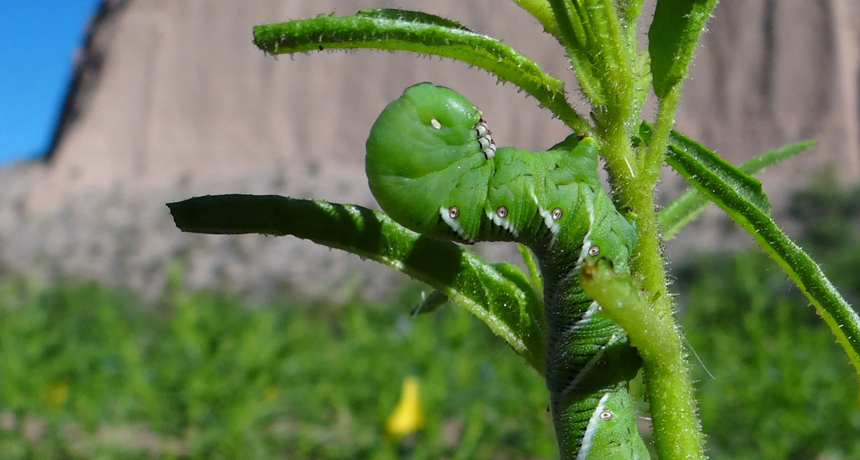
NICOTINE DEFENSE Tobacco hornworm caterpillars use some of the nicotine in their food to produce a smoker’s breath strong enough to drive away predatory wolf spiders.
Courtesy of Pavan Kumar
Eating wild tobacco plants produces such noxious breath in hornworm caterpillars that predators reel backward and flee upon encountering it.
“I think it’s actually the first example of using bad breath as a defense, although I’m sure that everybody has had a personal encounter of something similar,” says Ian Baldwin of the Max Planck Institute for Chemical Ecology in Jena, Germany.
As a plant defense, nicotine works by poisoning a variety of creatures. But the plump, striped tobacco hornworm caterpillar (Manduca sexta) can repurpose the poison to generate “toxic halitosis,” Baldwin says.
When a hornworm feeds on a wild tobacco plant, a touch of the plant’s nicotine is diverted into the insect equivalent of a bloodstream. Baldwin and his colleagues identified a gene that is involved in diverting 0.65 percent of ingested nicotine to create smoker’s breath strong enough to fend off attacking wolf spiders, the researchers report December 30 in the Proceedings of the National Academy of Sciences.
The spiders “just touch them — uff! — and jump away,” Baldwin says.
Yet the night-prowling wolf spider Camptocosa parallela readily eats hornworms that nibble other kinds of plants that aren’t laced with nicotine.
Defense by tobacco takes its toll, though. Nicotine stunts caterpillar growth a bit, Baldwin says. And unlike a cigarette for a human smoker, nicotine turns hornworms sluggish.
Caterpillar smoker’s breath is a new basic insight into an insect that chemical ecologists have been studying for so long that it should be “depressingly familiar,” says entomologist May Berenbaum of the University of Illinois at Urbana-Champaign. And the new insight “would never have been uncovered in just the lab environment.”
Baldwin and his colleagues discovered the hornworms’ chemical defenses by putting lab-engineered plants out into natural environments. Such experiments aren’t welcome in Germany, so the researchers plant their coyote tobacco (Nicotiana attentuata) at a research station in Utah.
On nicotine-free versions of coyote tobacco in Utah, hornworms disappeared in unusual numbers at night. Researchers eventually fingered predatory wolf spiders.
In a series of experiments, researchers shut down a gene, CYP6B46, that is normally active in the guts of caterpillars eating the plants. As the researchers dialed back midgut activity of CYP6B46, diversion of nicotine into the “bloodstream” and production of smoker’s breath dwindled.
Researchers don’t know just how the gut gene might cause diversion, or what’s happening to all the rest of the nicotine. Some 45 to 60 percent gets excreted, but researchers don’t see signs of the detoxified forms of nicotine that human smokers produce. So that leaves a chunk of caterpillar nicotine still to be accounted for.
BAD BREATH, GOOD DEFENSE A tobacco hornworm caterpillar fed its usual fare puffs out a warning that deters a predator spider (shown in slow motion). But a caterpillar that ate only nicotine-free plants has no such shield and proves an easy meal for the spider.
Credit: Sagar Pandit, P. Kumar et al/PNAS 2013.





